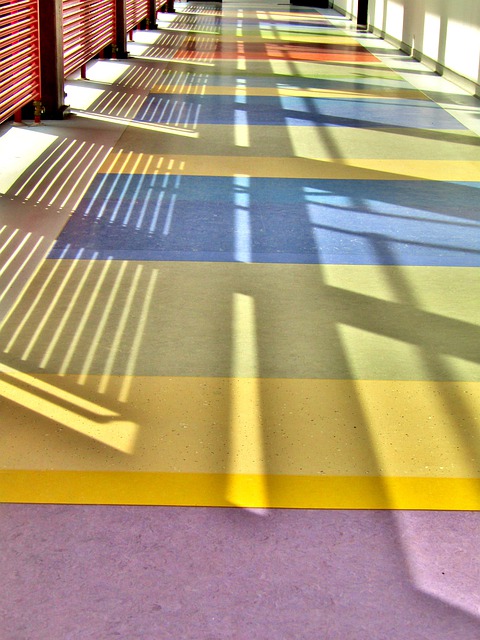Linoleum

|
Linoleum (usually abbreviated to ‘Lino’) is a traditional, smooth, seamless floor covering that is made by combining linseed oil, rosin (solid pine resin), flax, cork flour, wood flour, pigments and other ingredients. The name is a combination of two Latin words: linum (flax) and oleum (oil). During the manufacturing process, the oil is oxidised, a process that is aided by heating and which makes the oil solidify into a resilient, tough sheet.
The process of combining renewable, natural ingredients and pressing them onto a canvas backing to form sheets was invented in England by Frederick Walton in 1860. By 1869, the product had become so popular that Walton began exporting to Europe and the US. He continued to refine the process right up to the early 20th century when he invented an inlay machine that could produce patterned linoleum which proved to be extremely durable.
From its invention right up to the 1960s, linoleum was a popular floor covering which, being seamless, provided a surface that could be hygienic, easy to lay and easy to clean. Originally used for hallways and corridors, it soon spread to kitchens, bathrooms and even living rooms.
Lino is still made today but by a fast-tracked process. However, it is not made in the same quantities and has been largely superseded by synthetic floor coverings such as vinyl and wood laminates. Vinyl has become very popular and has around the same flexibility and durability, but it is less flammable and is supplied in colours which can be brighter and more translucent.
Another differentiator is that while linoleum has the design embedded throughout its constituent materials, modern vinyl coverings have three layers, one of which is an image layer which can carry a pattern or representation of stone, wood etc. Linoleum may also require a protective seam sealant to avoid water penetration.
Despite falling sales since the late 1960s, linoleum sales started to rise in the first two decades of the 21st century. In the UK, it is chiefly manufactured under the trade name of Marmoleum by Kirkaldy-based Forbo Nairn. Hailed as CO2 neutral from cradle to grave, it contains 97% natural raw materials, 72% rapidly renewable and 43% recycled content. It is available in a range of colours and designs which include marble and concrete.
Benefits of linoleum.
- Environment friendly.
- Low VOC content.
- Provides a cushioned, relatively comfortable floor.
- Water resistant.
- Easy to clean.
- Durable.
- Relatively easy installation, especially in tile format.
- Availability in a variety of colours and patterns.
- Continuous colour can mean dents and scrapes are less conspicuous.
[edit] Related articles on Designing Buildings Wiki
- Ash or oak wood flooring.
- Cork flooring.
- Domestic floors: Part 1: Construction, insulation and damp proofing.
- Floor definition.
- Flooring defects.
- How to fit carpet.
- Insulation for ground floors.
- Raised floor.
- Resilient Floor Covering Institute.
- Resilient flooring.
- Resin flooring.
- Rubber flooring.
- Screed.
- Separating floor.
- Sprung floor.
- Terrazzo.
- The Differences Between Engineered Flooring and Solid Hardwood Flooring.
- Types of carpet.
- Types of floor.
Featured articles and news
Infrastructure that connect the physical and digital domains.
Harnessing robotics and AI in challenging environments
The key to nuclear decommissioning and fusion engineering.
BSRIA announces Lisa Ashworth as new CEO
Tasked with furthering BSRIA’s impressive growth ambitions.
Public buildings get half a million energy efficiency boost
£557 million to switch to cleaner heating and save on energy.
CIOB launches pre-election manifesto
Outlining potential future policies for the next government.
Grenfell Tower Inquiry announcement
Phase 2 hearings come to a close and the final report due in September.
Progress from Parts L, F and O: A whitepaper, one year on.
A replicated study to understand the opinion of practitioners.
ECA announces new president 2024
Electrical engineer and business leader Stuart Smith.
A distinct type of countryside that should be celebrated.
Should Part O be extended to existing buildings?
EAC brands heatwave adaptation a missed opportunity.
Definition of Statutory in workplace and facilities management
Established by IWFM, BESA, CIBSE and BSRIA.
Tackling the transition from traditional heating systems
59% lack the necessary information and confidence to switch.
The general election and the construction industry
As PM, Rishi Sunak announces July 4 date for an election.
Eco apprenticeships continue help grow green workforce
A year after being recognised at the King's coronation.
Permitted development rights for agricultural buildings
The changes coming into effect as of May 21, 2024.





















